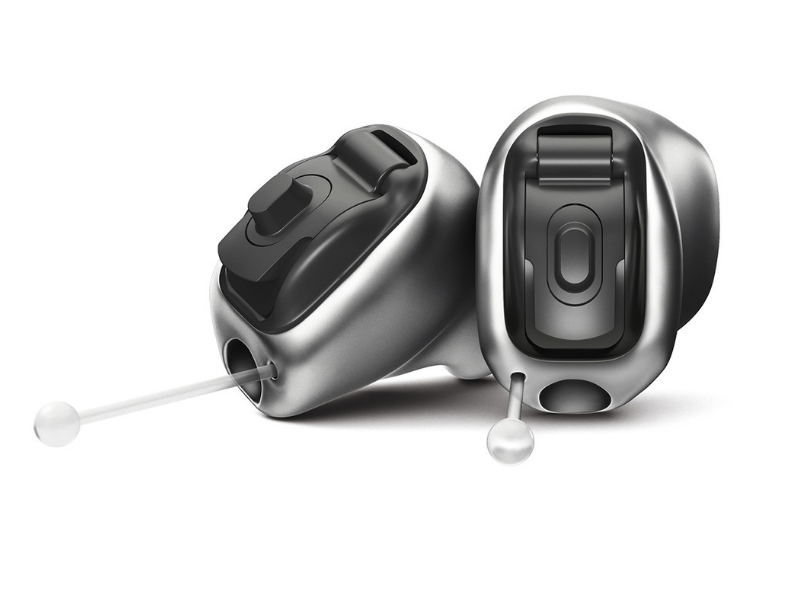
Invisible hearing aids represent a significant advancement in audiology, offering a discreet, around-the-clock solution for individuals with hearing loss. These groundbreaking devices, barely noticeable due to their minuscule size and strategic positioning within the ear canal, amplify sound and mitigate the stigma often associated with wearing a hearing aid. With improved sound quality and increased self-confidence, these hearing aids enhance users’ overall quality of life.
At South East Hearing Care Centres, our highly skilled audiology professionals are ready to provide customised hearing healthcare in a comfortable, calm environment. We take the time to thoroughly assess your hearing needs and match you with the perfect hearing aids to suit your lifestyle and budget. Our clinics offer a wide range of invisible hearing aids tailored to meet diverse individual needs and lifestyle preferences. The leading brands we offer, like Starkey, Widex, and Phonak, use state-of-the-art features to enhance speech clarity, reduce background noise, and stream audio from smartphones and entertainment systems.
Whether your hearing difficulties are mild or severe, sudden or gradual, our South East Hearing Care Centres clinicians approach each client with expert care and thoughtful guidance. We want you to hear better and fully connect with your loved ones.
Our centres are located in Horsham, Chichester, and Seaford. They are staffed by experienced audiologists who provide in-depth assessments and personalised care. Book an appointment at one of our clinics today to find the right hearing aid for your needs.
Benefits of Invisible Hearing Aids
The benefits of invisible hearing aids are significant, providing a discreet solution for individuals facing hearing difficulties.
More Discreet
Invisible hearing aids place the entire device deep within the ear canal, completely hiding it from view. Unlike behind-the-ear or receiver-in-canal styles, which have visible components, invisible hearing aids allow you to hear better without anyone noticing you are wearing hearing devices. This discreetness prevents you from being stigmatised or self-conscious about wearing visible hearing aids.
More Comfortable
With invisible hearing aids sitting deeper in the ear canal, they don’t have any external components that can feel bulky or rub against your outer ear. Rather than a plastic piece behind your ear, the in-canal fit feels lighter and more natural while allowing customised amplification based on your hearing needs. Without any external parts, invisible hearing aids are also easier to wear with glasses.
Better Sound Quality
The position of invisible hearing aids closer to the eardrum inside the ear canal allows sound to travel directly into the canal without dampening, which can occur with traditional external hearing aids. Sound is clearer and more natural as it is amplified closest to your eardrum.
Less Whistling/Feedback
Because invisible hearing aids sit deeper in the ear canal with a tight seal, issues with whistling or feedback are significantly reduced compared to other styles. There is less sound leakage coming out of the ear, and the physical barrier helps sound travel directly to the eardrum rather than reverberating within the ear cavity.
Easier Telephone Use
With no components behind the ear, invisible hearing aids allow for easier telephone use without interference or sound dampening between the phone and your ear canal. The microphone in the canal picks up your voice naturally, and there’s no need to adjust your phone or its position to have a comfortable conversation.
Frequently Asked Questions about Invisible Hearing Aids
How long does the battery of an invisible hearing aid typically last?
The longevity of a hearing aid battery typically depends on its type and usage. On average, most batteries last 3 to 22 days, with regular use and proper maintenance being key factors in their lifespan.
Are invisible hearing aids suitable for all types of hearing loss or difficulties?
Not all hearing loss or difficulties can be addressed with the same solution. The suitable aid depends on the specific condition, severity of hearing loss, and individual lifestyle needs of the patient.
Are any side effects or discomfort associated with the long-term use of invisible hearing aids?
Long-term use of hearing aids may occasionally result in minor discomfort or irritation. Side effects can include ear canal itchiness, feedback noise, or perceived changes in one’s own voice. Regular adjustments can mitigate these issues.
Can invisible hearing aids be worn during activities such as swimming or showering?
While certain hearing aids are designed to withstand moisture and sweat, wearing them during activities such as swimming or showering is generally not recommended due to potential water damage. Speak to your audiologist to check whether your hearing aids are water-resistant.
How does the maintenance and cleaning process for invisible hearing aids differ from other types of hearing aids?
The maintenance and cleaning process for hearing aids typically involves daily cleaning, regular checks for wax blockages, and periodic professional servicing. Specific procedures may vary depending on the model and type of hearing aid.